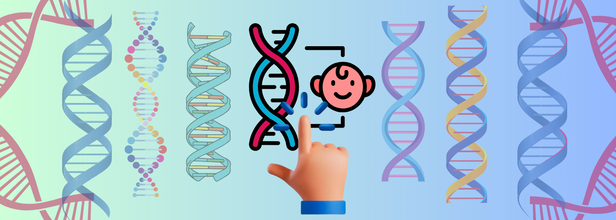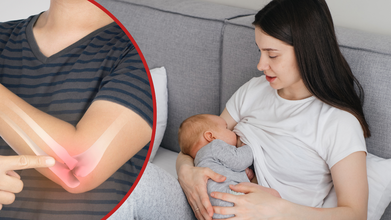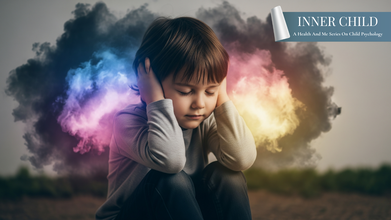- Health Conditions A-Z
- Health & Wellness
- Nutrition
- Fitness
- Health News
- Ayurveda
- Videos
- Medicine A-Z
- Parenting
- Web Stories
The Dream Of 'Super Breed Babies' Is Becoming A Reality In Silicon Valley, Babies Are Now Not Just Born, But Selected

Credits: Canva
When Roshan George and Julie Kang were told during IVF testing that they both carried a rare gene linked to early-onset hearing loss in infants, they didn’t hesitate to dig deeper. Like many in San Francisco’s tech scene, they turned to data. It was not just any data, but a full genomic analysis of their embryos from a start-up called Orchid.
It cost them $30,000 to screen 12 embryos. Six were viable. They sorted through risk scores for everything from bipolar disorder to type 2 diabetes, eventually selecting the embryo with the best odds. Their daughter, Astra, was born this March. She was healthy and was born with perfect hearing.
What this couple did might sound like a glimpse into the distant future. But in Silicon Valley and beyond, it’s already happening.
Also Read: What is Glioma? Walking Dead Actress Kelly Mack Dies at 33 After Battling Rare Brain Cancer
Silicon Valley’s Fertility Revolution
Orchid, a fertility start-up based in San Francisco, reports the Washington Post, is spearheading a radical new chapter in human reproduction. Founded by Noor Siddiqui, the company offers whole-genome sequencing of embryos created through IVF, allowing parents to screen for over 1,200 single-gene disorders, and to assess the embryo’s genetic risk for more complex diseases like cancer, schizophrenia, and Alzheimer’s.
In Siddiqui’s words, the goal is to help build “a generation that gets to be genetically blessed and avoid disease.”
At $2,500 per embryo, in addition to the roughly $20,000 average cost of one IVF cycle, the service is far from accessible to everyone. But in data-driven tech hubs like San Francisco and Austin, it’s catching on fast.
Sex Is For Fun. Embryo Screening Is For Babies
“Sex is for Fun. Embryo Screening is for Babies.”
That’s how Siddiqui sums up the shifting mindset. She imagines a future where sex is decoupled from reproduction, and where couples routinely pick their children using spreadsheets and algorithms. Sounds too robotic? But it really isn't even a distant future, it is slowly becoming reality.
At a private dinner party in Austin last spring, Siddiqui pitched her vision to a group of women sipping mocktails and wearing pastel baseball caps with one word: BABIES.
One of the attendees, reports the Washington Post, Shivon Zilis, who is a tech executive and mother to several of Elon Musk’s children, is reportedly an Orchid client. Sources say at least one of her children with Musk is an Orchid baby.
Siddiqui, now 30, plans to have four children herself using embryos screened by her own company.
The Promise of Prediction
So how does it work? Orchid uses five cells from an early-stage embryo to sequence the full human genome, a feat many geneticists previously believed impossible. It then uses machine-learning models to produce polygenic risk scores, predicting an embryo’s likelihood of developing certain diseases.
Backed by high-profile investors like Coinbase CEO Brian Armstrong and Ethereum co-founder Vitalik Buterin, Orchid is now in over 100 IVF clinics in the U.S.
The tech is built for a specific demographic: affluent, tech-savvy, data-worshipping individuals willing to invest in what one investor called a “genetic trust fund” for their future kids.
A Trust Fund of Traits Or Modern Eugenics?
The term eugenics makes many recoil. Siddiqui distances herself and her company from the idea, and insists the goal is about health, not perfection. But critics are wary.
When you screen for risk factors like schizophrenia, are you also unintentionally screening out traits tied to creativity? Could polygenic scores become a gateway to selecting for intelligence, height, or athleticism? And is this a privilege only the rich can afford?
Some scientists argue and the Washington Post reports, that these tools give an illusion of control. “It’s easy to moralize from an ivory tower when your child isn’t the one who might be born with a fatal disease,” said Orchid spokeswoman Tara Harandi-Zadeh.
Still, others worry about the science itself.
The Fault in the Genes?
One of Orchid’s biggest scientific claims is that it can sequence an entire genome from just five embryonic cells. This is hotly contested. Svetlana Yatsenko, a clinical genetics expert at Stanford, called it “basically Russian roulette,” citing errors introduced in the DNA amplification process.
Others are skeptical of the reliability of polygenic risk scoring, especially for traits like intelligence where predictive accuracy is extremely low, just a few IQ points at best. These risk scores also struggle with accuracy in non-European populations because the databases they draw from are largely Eurocentric.
Siddiqui acknowledges the challenge. Her husband is Middle Eastern, and she herself is South Asian. She says Orchid adjusts for population bias and, in some cases, doesn't offer scores at all.
No Rules, All Risks?
What’s striking is the lack of regulation. In the U.S., there are no real restrictions on what kinds of predictions companies like Orchid can sell. Their algorithms are proprietary and not vetted externally.
Despite the American College of Medical Genetics and Genomics advising against embryo screening for polygenic risks and calling the benefits “unproven”, companies are surging ahead. A newer Thiel-funded start-up, Nucleus, claims it can screen embryos for more than 900 traits and conditions.
As Peter Kraft, a Harvard expert on polygenic scores, put it: “The science doesn’t add up.”
Still, Parents Want Information
Despite the skepticism, demand is rising, notes the Washington Post. Many parents, especially those facing infertility or rare genetic conditions, are desperate for clarity. The George-Kang family didn’t expect certainty. They just wanted more information, more peace of mind.
“I think everyone who wants to have a baby should be able to have one,” Siddiqui told The Washington Post. “And they should be able to have a healthy baby.”
Critics might call it premature, or even dystopian. But to Siddiqui, it’s personal. Her mother lost her sight to a rare genetic disease. To her, it’s not just about tech, it’s about giving families a fighting chance.
The Future of Fertility
Whether Orchid’s vision becomes mainstream or remains an elite niche remains to be seen. But the door has opened to a future where reproduction is shaped not by nature, but by code, choice, and capital.
The baby of tomorrow may not be conceived in passion, but in planning and through lab reports, data sets, and algorithmic scores.
And in Silicon Valley, that future is already being born.
Strong Babies, Weak Bones? Does Breastfeeding Actually Cause Women To Lose Bone Density?

(Credit-Canva)
Pregnancy changes a woman’s body in many different ways. Not only do women experiences changes in their hormonal balance, but they also find that things like pelvic pain urine leakage etc., may become permanent as well.
It is also not new information how a mother’s body prioritizes the health of the baby, over its own sustenance, however, does that mean this could cause the mother’s health to suffer permanently?
A few studies have suggested that women who breastfeed often lose their bone density, causing them issues like osteoporosis. Osteoporosis, a condition that makes bones weak and brittle, is a big health concern, especially for women after menopause. Doctors and researchers have long wondered if pregnancy and breastfeeding could play a role in this later in life.
The main idea is that during pregnancy and breastfeeding, a woman's body needs a lot of calcium for the baby. This high demand, along with low estrogen levels, might affect the mother's bone health.
Does Breastmilk Draw Nutrient From Women’s Bones?
According to National Institute of Arthritis And Musculoskeletal And Skin Diseases during both pregnancy and breastfeeding, a mother's body needs a lot of calcium to help her baby grow. Some of this calcium comes from the mother's bones, which naturally causes a temporary decrease in her bone density. This is a normal part of pregnancy and breastfeeding and usually happens most during the third trimester and while she is nursing.
While a temporary decrease in bone density is normal during pregnancy and breastfeeding, your bone density usually returns to normal after you give birth and during or after you stop breastfeeding.
However, in very rare cases, some pregnant or nursing women might develop osteoporosis. This can lead to fractures, especially in the spine, that can happen without much stress or injury.
Does Breastfeeding Increase Risk of Osteoporosis?
Many studies have looked into this issue, but there is still no clear answer. Some research suggests a link, while other studies don't. Because there's no agreement among experts, a 2024 study was done to get a better understanding. Researchers reviewed all the available information on osteoporosis, pregnancy, and breastfeeding to see what the facts currently show.
However, what researchers found was much different than they anticipated. Researchers at UC San Francisco and UC Davis solved the mystery of how breastfeeding women's bones stay strong even when calcium is taken from them to make milk. They discovered a new hormone called Maternal Brain Hormone (MBH), also known as CCN3, that makes bones stronger and denser. This finding, published in Nature, could one day help people with broken bones and diseases like osteoporosis.
Could This Research Lead To Better Bone Health Care?
The researchers found that when they gave MBH to young and old mice, both male and female, their bones became much stronger. In some very old female mice that had no estrogen (which normally helps build bones), the hormone was able to more than double their bone mass.
To see if MBH could help with healing, the scientists created a special gel patch that slowly released the hormone onto a broken bone. In older mice, whose bones normally don't heal well, the patch helped new bone form and heal the fracture. This successful outcome has never been seen before with other treatments. The researchers are excited about the potential of MBH to help people with various bone conditions, including:
- Women after menopause who are at high risk for osteoporosis, a disease that causes bones to become weak and break easily.
- Breast cancer survivors who lose bone mass from their treatment.
- Elite female athletes.
- Older men who have suffered a hip fracture.
How Much Calcium Do Women Need?
The amount of calcium a woman needs each day doesn't change when she is pregnant or breastfeeding.
Ages 14-18: 1,300 mg per day.
Ages 19 and older: 1,000 mg per day.
Getting more calcium than these recommended amounts from food or supplements won't stop the temporary bone loss that happens during this time. For this reason, extra calcium doesn't have a big impact on how much bone a woman loses. If you're pregnant or nursing and are thinking about taking a calcium supplement, you should always talk to your doctor first.
Inner Child: Sensitive Kids Aren’t “Too Emotional,” They Just Experience Feelings Differently

Credits: Health and me
Inner Child’ is Health and Me's new mental health series where we deep dive into lesser-known aspects of child psychology and how it shapes you as you grow up. Often unheard, mistaken, and misunderstood, in this series we talk about the children’s perspective and their mental health, something different than you might have read in your parenting books. After all, parenting is not just about teaching but also unlearning.
Teachers and parents have, for many years, branded some children as "too emotional" or "too sensitive." Behind these words, there is usually a good intention hiding a misunderstanding these children are not broken or overreacting. They have nervous systems that are designed to feel more deeply, more intensely and more tenaciously than other children.
What this actually is, is that sensitivity in children is not as much about weakness as it is about difference. Grasping that difference is important to creating emotionally healthy, resilient, and confident kids.
Why Sensitivity Isn't a Flaw?
High sensitivity is an old phenomenon. Psychologist Dr. Elaine Aron originally described the "Highly Sensitive Person" (HSP) in the 1990s, explaining that about 15–20% of the population is more sensitive to sensory input, feelings, and surroundings. Kids who meet this criterion view the world with a intensity that at times overwhelms them—but it also provides them with special strengths.
Sensitive children sense subtleties that most others do not. They can sense the tension in a room before anyone says a word, catch the smallest change in a friend's mood, or be deeply touched by music, art, or literature. The catch is that they also take on more stress, criticism, and conflict, causing adults to write them off as dramatic or breakable.
But studies indicate that this more intensive processing is not a deficiency. Instead, sensitive children tend to exhibit greater empathy, creativity, and sensitivity. Their ability to "feel big" is a double-edged sword: painful at times, but equally beautifully enriching.
Neurological research indicates that sensitive children might have variations in brain response patterns. Functional MRI scans of extremely sensitive individuals demonstrate more activation of areas associated with awareness, empathy, and emotional control.
Simply put, when most children experience sadness, happiness, or fright, the emotional reaction goes away fairly quickly. Sensitive children, on the other hand, experience the same emotion through several layers—cognitive, sensory, and empathetic. This means it's a longer, more powerful emotional experience.
Parents tend to misunderstand this as exaggeration. What's actually occurring is not an exaggeration—it's amplification. Their internal world is cranked up a few degrees, so the same emotional incident registers differently.
How Sensitivity Appears in Childhood?
All children show sensitivity in their unique way, but there are some common patterns that psychologists and pediatricians observe in highly sensitive children:
Deep emotional responses: Crying, laughter, or irritation that appear out of proportion to the context.
Profund empathy: Consoling friends, fretting about others, or even getting distressed at news reports or animal cruelty.
Overwhelmed in bustling settings: Busy classrooms, loud birthday parties, or disruption to routine can cause meltdowns.
Perfectionism and self-criticism: Sensitive children can be perfectionists, setting high expectations for themselves and crushing themselves when they fail.
Rich inner lives: They usually adore telling stories, daydreaming, or role-playing, channelling feelings through creative expression.
What adults perceive as "too much" is actually a system that has yet to master regulating or expressing its depth.
What Is The Cost of Mislabeling Sensitive Kids?
When adults dismiss a child’s emotions with phrases like “Don’t be so dramatic” or “You’re too sensitive,” they unintentionally send a message: your feelings aren’t valid. Over time, this can teach children to suppress or distrust their emotions, leading to anxiety, self-doubt, or difficulties in relationships.
Worse still, some kids start to internalize shame. They may think there's something wrong with them because they care too much, cry a lot, or require more recovery time after stressful situations.
Psychologists caution that this criticism of themselves can extend into adulthood, manifesting as people-pleasing behaviors, burnout, or difficulty setting boundaries.
Reframing Sensitivity as Strength
The major turn is to redefine sensitivity as an asset--not a shortcoming. Research indicates that sensitive children who are raised in nurturing environments end up flourishing more than their less-sensitive counterparts. They do exceptionally well in empathy-related professions, are highly creative, and tend to have excellent emotional intelligence.
This is known as differential susceptibility: sensitive children are more influenced by their environments, both good and bad. That means that criticism can cut them deeply, but praise and understanding can enable them to blossom way above the norm.
How Parents Can Support a Sensitive Child?
Raising or teaching a sensitive child needs patience and redefining expectations. Some things supported by developmental psychology are:
1. Validate, Don't Dismiss
Instead of telling a child they’re overreacting, acknowledge what they’re feeling: “I see you’re really upset. Let’s take a moment together.” This doesn’t mean indulging every emotional swing, but showing their emotions have value.
2. Teach Emotional Regulation
Sensitive kids need tools to navigate their depth. Breathing exercises, mindfulness, journaling, or even physical activity can help them move through overwhelming feelings in healthier ways.
3. Create Safe Recovery Spaces
Quiet time following school, reading nooks, or soothing bedtime rituals provide sensitive children with a space to unwind from overstimulation.
4. Support Their Strengths
Emphasizing creativity, empathy, or critical thinking helps sensitive children realize their sensitivity is an asset rather than a weakness.
5. Model Healthy Emotional Expression
Kids learn from what they see. Parents who express their own emotions openly and calmly are teaching children that feeling deeply is ordinary and navigable.
How a sensitive child is treated during early years determines their adult life fundamentally. Those who are nourished end up being empathetic leaders, artists, caregivers, or innovators. Those who are shamed end up being adults with anxiety, depression, or identity issues.
Therapists working with highly sensitive adults often trace the roots of their struggles back to childhood experiences where emotions were invalidated. The “inner child” work many undergo in therapy is essentially about reconnecting with that sensitive child, acknowledging their feelings, and offering the validation they never received.
Calling sensitive children "too emotional" isn't just missing the point—it can do lasting damage. It's an era when mental health issues are increasingly on the rise globally, and recognizing the complexity of emotions is more necessary than ever.
Rather than trying to teach children to toughen up, we need to teach them to find their way through their emotional worlds with confidence. Sensitivity is not something to be fixed it's a kind of intelligence to be cultivated.
Each child feels emotions differently, but for highly sensitive children, they feel them in high definition. They don't need to be "fixed"; they need to be guided, supported, and validated. When we shift away from belittling them as "too emotional" and towards valuing their depth, we open the door for them to become compassionate, innovative, and resilient adults.
Parents, Have You Given Your 12-Year-Old A Smartphone? Global Study Links Early Use To Serious Mental Health Risks

Credits: Canva
A smartphone in the hands of a child might look harmless—useful, even. It offers parents peace of mind, connects children with friends, and provides access to learning tools. But new research suggests that early smartphone ownership could carry a hidden cost that lasts well into adulthood.
A global study involving more than 100,000 participants has found that young adults who first received a smartphone before age 13 report significantly worse mental health, including higher rates of suicidal thoughts, aggression, detachment from reality, and low self-worth. The findings, published in the Journal of Human Development and Capabilities, point to a troubling association: the younger a child is when they first own a smartphone, the greater their risk of long-term emotional and psychological struggles.
The research, led by Sapien Labs through its Global Mind Project—the world’s largest mental wellbeing database—focused on individuals aged 18 to 24. Those who had smartphones at 12 or younger consistently scored lower on the Mind Health Quotient (MHQ), a tool that measures social, emotional, and cognitive wellbeing.
Young adults who received their first smartphone at 13 averaged an MHQ score of 30.
Those who had one by age five averaged just 1—a near collapse in mental wellbeing indicators.
Symptoms tied most strongly to early smartphone ownership included suicidal thoughts, increased aggression, detachment from reality, and hallucinations.
The analysis showed the effects were consistent across cultures, languages, and regions, underscoring what researchers describe as a “critical window of vulnerability” during childhood development.
Why Early Smartphone Use Affects Mental Health?
Smartphones are not simply phones—they are portals into social media, gaming, and AI-driven feeds that shape how children perceive themselves and the world. Dr. Tara Thiagarajan, neuroscientist and lead author of the study, explains:
“Our data indicate that early smartphone ownership—and the social media access it often brings—is linked with a profound shift in mind health and wellbeing in early adulthood.”
Children under 13 appear to be particularly vulnerable to cyberbullying, poor sleep quality, and weakened family relationships, all of which can accumulate into mental health symptoms later in life. The study estimates that early access to social media accounts for about 40% of the association between smartphone ownership and adult mind health, with disrupted sleep and family strain contributing significantly as well.
How Screentime Is Impacting Kids Mental Health?
Traditional studies on screen time often focus narrowly on depression and anxiety. What makes this research stand out is its broader scope. Symptoms like aggression, detachment from reality, and suicidal ideation are not always captured in conventional mental health assessments. Yet these outcomes, according to the study, are rising sharply among younger generations and carry serious societal implications.
For instance, the proportion of young women classified as “distressed or struggling” rose by 9.5% when they received a smartphone before age 13. For men, the increase was 7%. While females often reported lower self-image and emotional resilience, males showed diminished calmness, empathy, and stability.
Are Smartphones Are A Boon Or Bane?
Since the early 2000s, smartphones have reshaped how young people learn, communicate, and build identity. Yet the same technology that holds out hope of connectivity also generates comparison, isolation, and access to toxic content. The recommendation algorithms that utilize AI technologies accelerate these dynamics, keeping kids trapped in scrolling loops that tend to replace sleep, face-to-face engagement, and family time.
While most social media sites limit accounts to people 13 and up, regulation is lax. As such, children as young as eight frequently set up accounts and partake in content intended for much older viewers.
Governments are starting to act. France, Italy, the Netherlands, and New Zealand have placed limits on the use of phones within schools. In the United States, states such as New York, Alabama, and Arkansas have enacted or proposed similar measures. Initial statistics from the Netherlands indicate these interventions enhance concentration in class, but the long-term mental health effects are uncertain.
Though the study doesn't establish causation, it can't conclusively state that smartphones lead to mental health downturns—it shows a robust and consistent relationship in various populations. Researchers note that other factors, including the COVID-19 pandemic, might have amplified these trends. Nevertheless, the size of the issue, impacting millions of young adults globally, is too large to overlook.
The argument about teen smartphone use is not merely about personal health, it's about the health of societies as a whole. Increasing levels of suicidal ideation, violence, and disconnection among young people have ripple effects, from compromised healthcare systems to reduced workforce productivity and eroded community ties.
By comparing the situation to existing restrictions on alcohol and tobacco, scholars contend that societies already possess blueprints for protecting children from dangerous substances and settings. The problem is finding the political will and interagency cooperation to apply those protections to the online world.
© 2024 Bennett, Coleman & Company Limited

